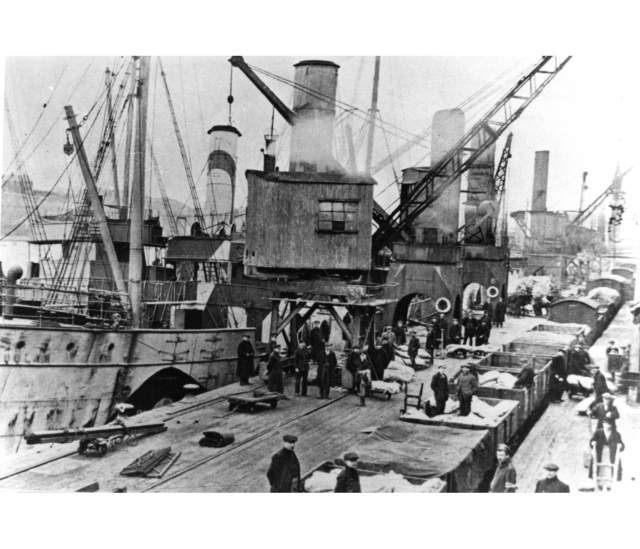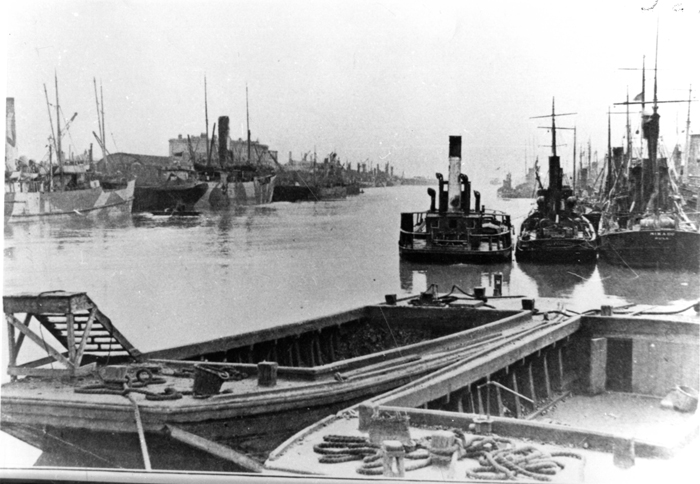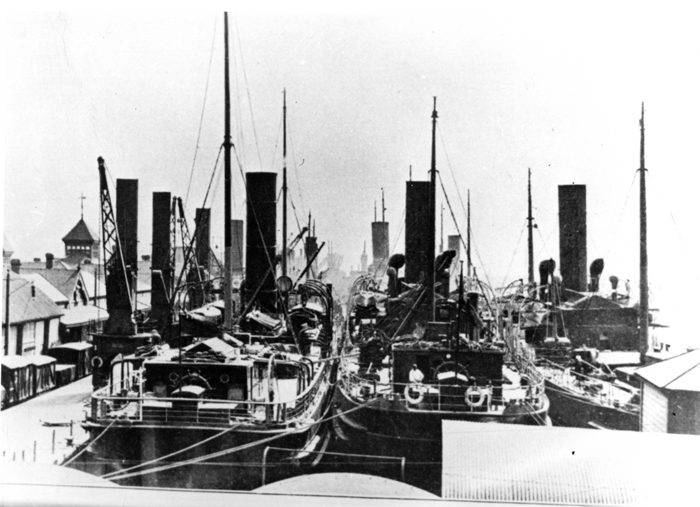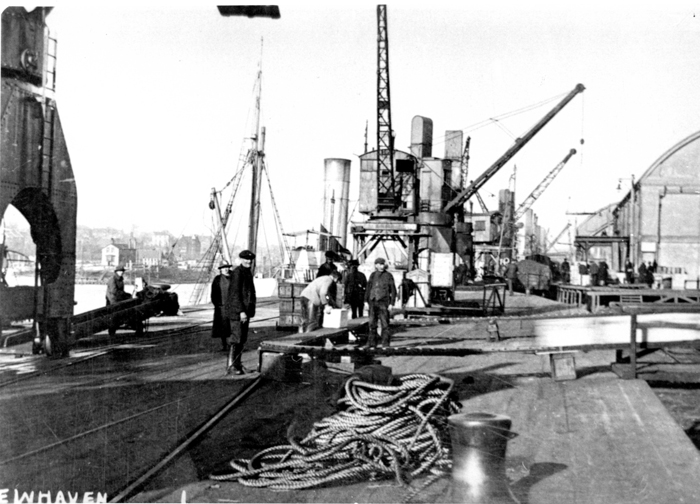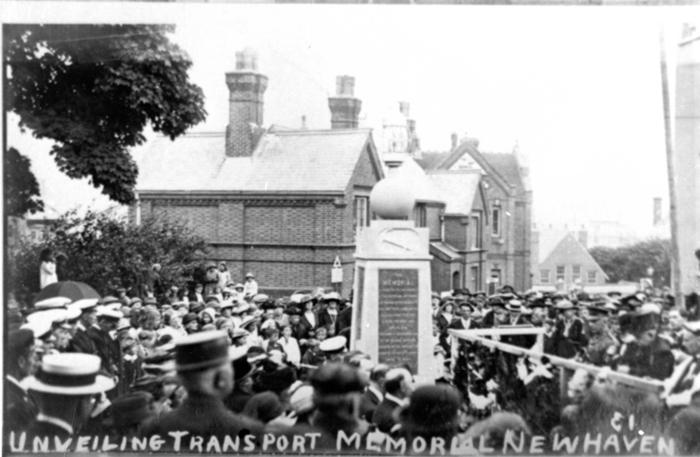During the First World War, the British Army in France needed to be regularly supplied with food, ammunition and equipment in order to continue fighting. The port of Newhaven was at the forefront of this supply effort.
Before the outbreak of the First World War, Newhaven was a key point in travel between Britain and Europe. Billed as being the fastest way to reach France, Newhaven was the departure port for the railway and steamship link from London to Dieppe. Passengers could ride the train down from London before boarding one of the twice daily steamships that would cross the channel in just under three hours. As a result, it was a key port for tourism and travel.
However, events on the continent before 1914 had led the British government to implement new policy and reforms that, in time, would drastically impact the port at Newhaven. After witnessing the swift defeat of France in the Franco-Prussian War in 1870-71, Britain attempted to modernise its own armed forces in case of conflict in Europe. A result of this was the approval of new laws granting the government power to requisition civilian shipping and ports to sustain any war effort.
At the outbreak of war in 1914, the Regulation of the Forces Act, 1871 allowed the government to quickly take control of Newhaven Port and it was subsequently closed to the public; all passenger services to France were suspended indefinitely.
Supplying the Army
Because of its position on the East Sussex coast, a position that had made it so useful for tourism, Newhaven was ideally placed to deliver supplies across the channel. However, in the early months of the war, the requirements of the military and the desires of private shipping companies often collided.
During 1914 and the early part of 1915, Britain was operating under a system often referred to as ‘Business as usual.’ Whilst the country may have been at war, the government was keen for the conflict not to have too great an effect on the day to day running of the nation on the home front. The hope was that the war would be swiftly won without overly disrupting trade and commerce.
The requisitioning of the port at Newhaven was at odds with this plan as it completely closed the area to all commercial shipping. Many private shipping companies were keen for military supplies to be moved from Newhaven to either Liverpool or Plymouth in order to reopen the East Sussex port to them. The Divisional Naval Transport Office (DNTO) stationed at Newhaven blankly refused this request. Instead of ‘Business as usual,’ the requisitioning of the port at Newhaven provided an early insight into what would be known as ‘Total War‘ where the government would be empowered to utilise any public or private industry to support the war effort for the duration of the conflict.
Following the decision to take control of Newhaven’s harbour, steamships were also requisitioned for the transportation of supplies across the channel. These supplies included ammunition, clothing, food, and horses. The return journeys from France would often include hospital ships returning wounded men to Britain.
By October 1915, 45 transport vessels were engaged in the cross-channel supply effort. Around 6,000 tons of supplies were being delivered to France by these ships every day and this number would rise considerably as the war progressed. In order to maintain the regularity of shipping, additional workers were sought to load ships at the quayside. Newly employed Chinese Labourers were used at Newhaven Harbour after 1917. Similarly, by February 1918, 100 women were employed to work the docks. Within a month this number had risen to over 400.
Defending the docks
Because of the nature of the ammunition supplies passing through Newhaven, the dock was under the control of the military. Newhaven Fort was garrisoned throughout the conflict to provide an armed overwatch of the port and surrounding coastline.
The military were particularly concerned at the possibility of either espionage or civil unrest in the town which would jeopardise the delivery of supplies. In 1916, the renowned pacifist and peace activist Bertrand Russell was repeatedly denied access to what was termed the ‘Newhaven Special Military Area’ in order to attend the Court Martial of a Private R.C. Allen. Eventually, special provision was made and Russell was granted a special permit that would allow him to travel from the train station, to the tribunal room, and back again. He was not permitted to visit anywhere else within the town.
The greatest fear regarding Newhaven, however, was the effect an attack on the town might cause. Alongside the guards at Newhaven Fort, the DNTO also obtained the services of eight boy scouts who kept watch from the clifftops from 6am until 10pm every day and also acted as messengers. Patrolling above them were seaplanes from the nearby base and airships from Polegate. These were tasked with the location of any German U-Boats that might be active in the channel and also identifying and potentially intercepting any incoming German planes and bombers.
Commander P.B. Garrett from the Naval Transports Office was keen to emphasise the huge danger of an attack on the port from either the air or by torpedo:
I would like to point out that it appears extremely essential that the ammunition Transports should never, when loaded, be allowed to remain in this harbour, as in the event of an air raid and a bomb being dropped on to any of these vessels the destruction of the whole of the quays and most of the town, would be the inevitable result. In consequence I am using the vessels that can leave at almost any hour of tide and larger than those now used could not be used to advantage.
The final total and final cost
By the conclusion of the war there could be no doubt over the huge role Newhaven had played in supplying the army abroad. Over the preceding years 866,021 train trucks had delivered war materiel to the quayside at Newhaven. These supplies had then been delivered to France by 165 ships making a total of 8,778 voyages. Over 6 million tons of supplies including 2.6 million tons of ammunition were delivered to France during these supply trips.
However, this titanic effort was not maintained without a noticeable cost. The names of 99 people who lost their lives whilst delivering supplies to France were inscribed on the Newhaven Transport Memorial following its unveiling in 1920.
Sources
Sussex in the First World War by Keith Grieves

